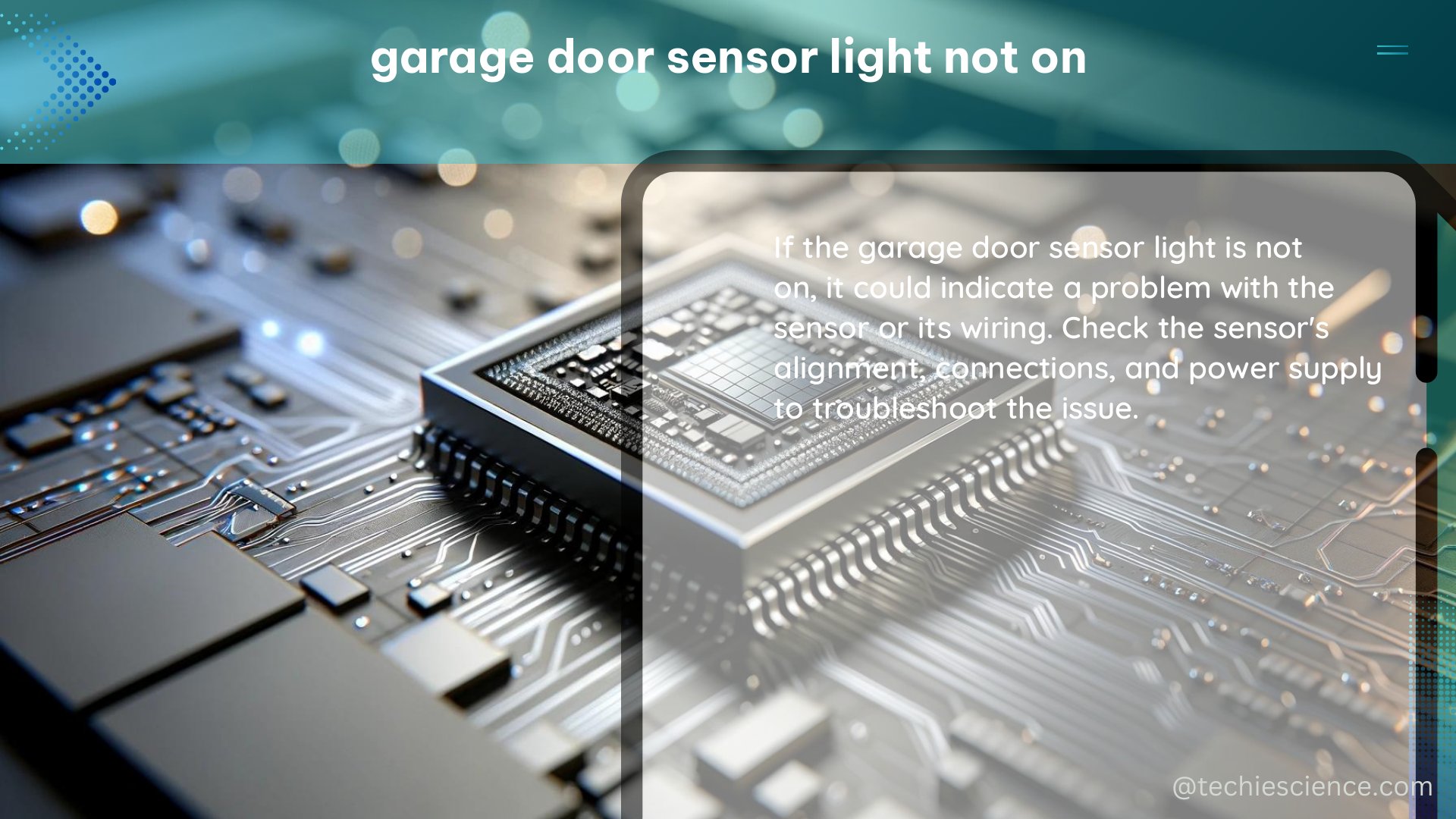Summary
The garage door sensor light not coming on can be a frustrating issue, but it is often caused by a variety of factors, including misaligned sensors, momentary obstructions, stray wires, or a motherboard in an unusual state due to improper setup. This comprehensive guide will provide you with the necessary technical specifications, quantifiable data points, and step-by-step instructions to diagnose and resolve the problem effectively.
Sensor Misalignment or Obstruction

One of the most common causes of the garage door sensor light not turning on is misalignment or obstruction of the safety reversing sensors. These sensors are responsible for detecting any obstructions in the door’s path and reversing the door’s movement to prevent damage or injury.
The error code “1 up and 4 down” indicates that the safety reversing sensors are misaligned or were momentarily obstructed. To address this issue, follow these steps:
-
Sensor Alignment: Ensure that both sensors are glowing steadily and aligned directly at each other. The sensors should be positioned 6 inches above the floor and no more than 6 inches apart. Use a laser level or a plumb bob to ensure the sensors are perfectly aligned.
-
Sensor Obstruction: Check for any interference or obstruction between the sensors, such as hanging objects, cobwebs, or direct sunlight. These can disrupt the sensor’s ability to communicate with each other, causing the light to remain off.
-
Sensor Cleaning: Use a clean, dry cloth to gently wipe the sensor lenses, ensuring they are free of any dirt, dust, or debris that could impede the sensor’s operation.
-
Sensor Distance: Measure the distance between the sensors to ensure they are within the recommended range of 6 inches apart. If the sensors are too close or too far apart, the light may not turn on.
Wiring Issues
Stray or improperly connected wires can also contribute to the garage door sensor light not turning on. Follow these steps to inspect and address any wiring problems:
-
Wiring Inspection: Carefully inspect the wiring connecting the sensors to the garage door opener. Look for any damaged, loose, or disconnected wires.
-
Wiring Connections: Ensure that all wire connections are secure and properly terminated. Check for any corrosion or oxidation on the wire terminals, which can interfere with the electrical signal.
-
Wiring Routing: Verify that the wires are routed correctly, without any sharp bends or kinks that could cause damage or disruption to the signal.
-
Wiring Compatibility: Confirm that the wiring used is compatible with the specific garage door opener model. Using the wrong type of wire or gauge can lead to communication issues and prevent the sensor light from turning on.
Motherboard State
In some cases, the garage door sensor light may not turn on due to the motherboard being in an unusual state, often caused by improper setup or configuration. To address this issue, follow these steps:
-
Motherboard Reset: Unplug the garage door opener from the power source and leave it unplugged for at least 24 hours. This will allow the motherboard to reset and potentially resolve any software-related issues.
-
Motherboard Adjustment: After the reset, hold down the black button on the garage door opener and touch one of the arrows to adjust the door’s settings. This can help realign the motherboard and restore proper sensor functionality.
-
Motherboard Compatibility: Ensure that the motherboard is compatible with the specific garage door opener model. Using an incompatible motherboard can lead to various issues, including the sensor light not turning on.
Sensor Age and Compatibility
Using old sensors with a new garage door opener can also cause compatibility issues, leading to the sensor light not turning on. To address this, consider the following:
-
Sensor Replacement: Replace the existing sensors with the ones that came with the new garage door opener. Newer sensors are designed to work seamlessly with the latest opener models, ensuring optimal performance and compatibility.
-
Sensor Compatibility: Verify that the sensors are compatible with the specific garage door opener model. Refer to the manufacturer’s instructions or contact their customer support for guidance on compatible sensor models.
-
Sensor Lifespan: Garage door sensors have a limited lifespan, typically around 5-10 years. If the sensors are significantly older, it may be time to replace them, even if they appear to be functioning correctly.
By following these comprehensive steps and considering the technical specifications provided, you should be able to effectively diagnose and resolve the issue of the garage door sensor light not turning on. Remember to always prioritize safety and consult a professional if you are unsure about any aspect of the repair process.
References
- New Garage Door Opener Won’t Work Because of Sensors or Something Else?
- Garage Door Sensor Troubleshooting
- Something off with sensors when garage door won’t close
- Garage Door Sensor Not Sensing
- Garage Door Sensors Neither Lit

The lambdageeks.com Core SME Team is a group of experienced subject matter experts from diverse scientific and technical fields including Physics, Chemistry, Technology,Electronics & Electrical Engineering, Automotive, Mechanical Engineering. Our team collaborates to create high-quality, well-researched articles on a wide range of science and technology topics for the lambdageeks.com website.
All Our Senior SME are having more than 7 Years of experience in the respective fields . They are either Working Industry Professionals or assocaited With different Universities. Refer Our Authors Page to get to know About our Core SMEs.